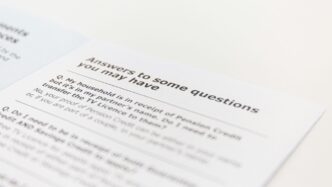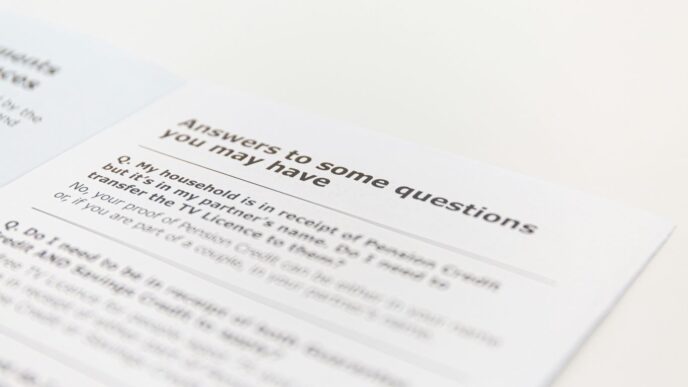Hiring the right person can feel like a puzzle. You want someone who fits the job and the team, but how do you actually find them? A good interview guide template is your secret weapon. It helps make sure you ask the right questions, stay fair, and don’t miss out on great candidates. Let’s break down how to make one that really works.
Key Takeaways
- Start by getting everyone involved who hires people. Talk about what you need and who does what. This makes sure everyone agrees on the plan for your interview guide template.
- Lay out the interview process clearly. What are the steps? What questions will you ask? Having a plan makes interviews fair and consistent, which is what a good interview guide template is all about.
- Think about questions that really show if someone can do the job. Use questions about past experiences or how they’d handle a made-up situation. This helps you see their skills in action.
- Once you have your interview guide template, share it with your team. Show them how to use it and where to find it. Training helps everyone use it the same way.
- Check if your interview guide template is working. Look at who you’re hiring, what candidates think, and how well new people do on the job. Use this info to make your template even better.
Establishing The Foundation For Your Interview Guide Template

Before you even think about writing down questions, you need to get everyone on the same page. This isn’t a solo mission; it’s a team sport. Making sure everyone involved in hiring understands what we’re trying to achieve is the first big step.
Collaborative Kickoff Meetings
Think of these meetings as the blueprint session for your hiring process. You’ve got the job opening, but what does ‘success’ look like for this role? Get the hiring manager, maybe a key team member, and HR in a room (or on a video call) to hash it out.
- What are the absolute must-have skills? Not just the nice-to-haves, but the deal-breakers.
- What kind of personality fits best with the current team? Are we looking for a quiet contributor or a loud idea person?
- What are the biggest challenges someone in this role will face in the first six months? This helps frame questions about problem-solving.
The goal here is to get a crystal-clear picture of the ideal candidate before you start looking. It sounds obvious, but you’d be surprised how often this part gets skipped.
Defining Roles and Responsibilities
Once you know who you’re looking for, you need to know who’s doing what in the hiring process. Who’s in charge of scheduling? Who’s asking the technical questions? Who’s assessing cultural fit?
Here’s a quick breakdown of who typically does what:
| Role | Primary Responsibilities |
|---|---|
| Hiring Manager | Defines role needs, final decision, assesses team fit |
| HR/Recruiter | Manages process, screens candidates, ensures compliance |
| Interview Panel | Assesses specific skills, provides feedback, asks questions |
| Team Member (Optional) | Offers peer perspective, assesses collaboration potential |
Having this mapped out stops confusion and makes sure no one’s stepping on anyone else’s toes. It also means you’re not asking the same questions three times.
Setting Communication Ground Rules
This is about how the hiring team talks to each other and, importantly, how they talk to candidates.
- Response Times: How quickly do we get back to candidates after an interview? Aim for a consistent turnaround, like 48 hours.
- Feedback Loop: How and when will interviewers share their notes and scores? Make sure it’s timely and in the right place.
- Confidentiality: What information can be shared with candidates, and what stays within the hiring team?
Clear communication rules prevent misunderstandings and make the whole process feel more professional for everyone involved, especially the people applying for the job.
Structuring Your Comprehensive Interview Guide Template
Alright, so you’ve got the basics down for your interview guide. Now it’s time to really build it out, making sure it’s not just a list of questions, but a real roadmap for your hiring team. This is where you get specific about what you’re actually looking for and how you’re going to find it.
Defining Role Clarity and Job Descriptions
Before you even think about questions, you need to be crystal clear on what the job actually entails. This means going beyond a generic job title. What are the day-to-day tasks? What problems will this person solve? What does success look like in this role after three months, six months, a year?
- List the top 3-5 responsibilities. What absolutely has to get done?
- Identify the key performance indicators (KPIs). How will you measure if they’re doing a good job?
- Describe the team dynamics. Who will they work with? What’s the team’s vibe?
This clarity isn’t just for the candidate; it helps your interviewers know what to focus on. If everyone’s on the same page about the role, the interviews will be way more productive.
Developing a Structured Interview Plan
This is where you map out the actual interview process. Think of it like a script, but with room for improvisation. A structured plan means every candidate gets asked similar questions, making it easier to compare apples to apples. It also helps keep the interview on track and covers all the bases.
Here’s a basic flow you might consider:
| Stage | Focus |
|---|---|
| Introduction | Welcome, set expectations, brief overview |
| Experience Review | Dig into resume, past roles, achievements |
| Skill Assessment | Behavioral/Situational questions |
| Candidate Questions | Allow them to ask about the role/company |
| Wrap-up | Next steps, timeline, thank you |
Having this plan means you’re not just winging it. You’re systematically gathering the information you need.
Incorporating Competency-Based Questions
Forget asking if someone’s a ‘team player’ and leaving it at that. Competency-based questions dig deeper. They focus on specific skills and behaviors that are proven predictors of success in a role. Instead of asking about hypothetical situations, you ask about past experiences. The idea is that how someone handled something before is a good indicator of how they’ll handle it in the future.
Think about the core competencies for the role. Are you looking for problem-solving? Leadership? Adaptability? For each competency, craft questions that start with phrases like:
- ‘Tell me about a time when you had to…’ (e.g., …deal with a difficult client, …manage multiple competing priorities, …learn a new skill quickly).
- ‘Describe a situation where you…’ (e.g., …failed to meet a deadline, …had to influence a decision, …worked under pressure).
- ‘Give me an example of how you…’ (e.g., …handled conflict within a team, …took initiative on a project, …adapted to a significant change).
By focusing on these kinds of questions, you get concrete examples of a candidate’s abilities, not just their opinions. It makes your evaluation much more objective.
Crafting Effective Interview Questions
Alright, let’s talk about the heart of the matter: the questions you ask. This is where you really get to see if someone is the right fit, not just on paper, but in how they think and act. It’s not just about ticking boxes; it’s about understanding the person.
Assessing Key Competencies and Skills
First off, you need to know what you’re even looking for. Before you write a single question, jot down the absolute must-have skills and traits for the job. Think about what someone actually needs to do day-to-day. Is it problem-solving? Teamwork? Technical know-how? Once you have that list, you can start building questions that get at those specific things. It’s like having a cheat sheet for what makes a good hire.
Utilizing Behavioral and Situational Questions
This is where things get interesting. Instead of asking someone if they can do something, ask them about a time they did do it. Behavioral questions, like ‘Tell me about a time you had to deal with a difficult client,’ are gold. They show you how someone actually behaved in a real situation. Situational questions are similar, but they present a hypothetical scenario: ‘What would you do if a project deadline was suddenly moved up?’ These questions help you see their thought process and how they’d handle challenges.
- Behavioral Questions: Focus on past actions.
- Situational Questions: Focus on future hypothetical actions.
- STAR Method: Encourage candidates to structure their answers using Situation, Task, Action, and Result. This makes their responses clearer and easier to compare.
Including Knockout Questions for Efficiency
Let’s be real, you don’t have all day. Some requirements are non-negotiable. Maybe it’s a specific certification, a certain number of years of experience, or the legal right to work. These are your knockout questions. If someone can’t answer them correctly, or they don’t meet the requirement, you can politely end the interview early. It saves everyone time and keeps the process moving. It’s about being respectful of everyone’s time, including your own.
Here’s a quick look at how you might categorize questions:
| Question Type | Purpose |
|---|---|
| Foundational | Basic qualifications, resume clarification |
| Behavioral | Past actions, problem-solving, teamwork |
| Situational | Hypothetical scenarios, decision-making |
| Role-Specific Skills | Technical abilities, job knowledge |
| Knockout | Non-negotiable requirements |
Implementing Your Interview Guide Template
So, you’ve put in the work and built a solid interview guide. That’s awesome! But a template sitting on your computer doesn’t do much good, right? The next big step is actually getting it out there and making sure everyone on your hiring team knows how to use it. Think of it like getting a new tool – you wouldn’t just hand it over without showing someone how it works.
Sharing the Template with Your Hiring Team
First things first, you’ve got to share the actual document. Email is fine, but honestly, a shared drive or a dedicated HR platform is even better. This way, everyone’s looking at the most up-to-date version. It’s super important that everyone on the hiring team, from the hiring manager to anyone else involved in the interview process, has access. Consistency is the name of the game here. If one person is using a completely different set of questions or a different format, your whole process gets messy, and you can’t really compare candidates fairly.
Providing Training on Template Usage
Just sharing the file isn’t enough, though. You really need to walk people through it. Schedule a meeting, maybe an hour or so, where you can go over the template section by section. Explain why certain questions are there. What are you trying to find out with that specific question? Give examples of what a good answer might sound like, and maybe even what a less helpful answer looks like. This isn’t just about ticking boxes; it’s about helping your team become better interviewers. You want them to feel confident asking the questions and, just as importantly, listening to and evaluating the answers.
Here’s a quick rundown of what to cover in training:
- Purpose of the Template: Why did we create this? What problems does it solve?
- Section Breakdown: Go through each part – introduction, core questions, candidate questions, closing.
- Question Focus: What specific skills or traits does each question aim to uncover?
- Evaluation Method: How should interviewers score or note down responses?
- Bias Awareness: Briefly touch on how the structured format helps reduce unconscious bias.
Establishing a Centralized Resource Repository
Beyond just the template itself, think about creating a central spot for all things interview-related. This could be a folder on your shared drive or a section in your HR software. What should go in there? Definitely the interview guide, but also maybe some sample questions for different types of roles, scoring rubrics if you use them, and even notes on company values that interviewers should be looking for. Having all this in one place makes it easy for anyone to find what they need, especially if you have new people joining the hiring team. It keeps everything organized and makes sure everyone is on the same page, which, as we’ve talked about, is a big deal for making good hires.
Evaluating The Success Of Your Interview Guide Template

So, you’ve put in the work, crafted this fancy interview guide, and rolled it out to the team. That’s great! But how do you actually know if it’s doing its job? It’s not enough to just have a template; you need to check if it’s actually helping you find good people.
We need to look at the numbers and see what’s really happening. This isn’t about guessing; it’s about getting real data to see if your template is a winner or if it needs some serious tweaking.
Analyzing Key Performance Indicators
This is where we get down to brass tacks. We need to track how well the hiring process is working now that you’ve got this guide. Think about things like how long it takes to fill a position, or how many people actually accept your job offers. Are candidates sticking around after they’re hired? These are all good signs of whether your template is pointing you in the right direction. You can track these using a simple spreadsheet or a more advanced system. Here’s a quick look at some common metrics:
| Metric | What it Tells You |
|---|---|
| Time to Fill | How quickly you’re bringing new people on board. |
| Offer Acceptance Rate | If candidates like your offer enough to say yes. |
| Cost Per Hire | How much money you’re spending to get someone hired. |
| Hiring Manager Satisfaction | If the managers are happy with the people you find. |
Assessing Diversity and Inclusion Impact
This is a big one. Your interview guide should be helping you build a more diverse team, not making it harder. You need to look at who’s making it through the interview process. Are candidates from different backgrounds getting a fair shot? Are you seeing a good mix of people at each stage? If your template is unintentionally filtering people out, that’s a problem. We want to make sure everyone has an equal chance to show what they can do. This means looking at the demographics of your applicant pool and comparing it to who gets interviews and who gets offers. It’s about fairness and building a stronger team with different viewpoints. You can find more on recruitment metrics to help guide this analysis.
Measuring Candidate Experience and Quality of Hire
What’s it like to interview with your company? Candidates talk, and a bad experience can hurt your reputation. So, after the interview, ask them! Send out a quick survey. Did they feel respected? Was the process clear? Did they understand the role? Good feedback here means a better employer brand. But it’s not just about the interview itself. We also need to think about the people you actually hire. Are they doing a good job? Are they sticking around? That’s the real test of whether your interview guide is helping you find the right talent. Looking at how well new hires perform after a few months, or even a year, gives you a solid idea of the quality of your hires. It closes the loop on your hiring efforts.
Refining Your Interview Guide Template Over Time
So, you’ve put together this awesome interview guide. That’s great! But here’s the thing: it’s not really a ‘set it and forget it’ kind of deal. Think of it more like a recipe you tweak over time to make it just right. The goal is to keep making your hiring process better, not just stick with what you did the first time.
Gathering Stakeholder Feedback
This is probably the most important step. Who knows if the guide is working or not? The people actually using it! That means your hiring managers, the interviewers, and even the candidates themselves. You’d be surprised what you can learn from just asking.
- Interviewers: Ask them what questions felt awkward, which ones really got good answers, and if anything felt missing. Did they have enough time to really get to know the candidate?
- Hiring Managers: They’re the ones who have to live with the new hire. Ask them if the candidates they’re seeing actually match what they need. Are the skills and personality traits coming through in the interviews?
- Candidates: A quick, anonymous survey after the interview can be gold. Ask about their experience. Did they feel the process was fair? Did they understand the role? This also helps your company’s reputation.
Adapting Templates for Different Roles
Look, a template is a starting point, not a rigid rulebook. You wouldn’t use the same interview questions for a software engineer as you would for a sales rep, right? The core structure of your guide should stay the same – that’s for consistency. But the specifics? Those need to change.
| Role Type | Key Competencies to Focus On | Example Question Type |
|---|---|---|
| Technical | Problem-solving, specific coding languages, system design | Hypothetical coding challenges, past project deep dives |
| Sales | Persuasion, relationship building, closing ability | Role-playing sales scenarios, past client success stories |
| Customer Support | Empathy, communication, conflict resolution | Handling difficult customer situations, de-escalation tactics |
Scheduling Regular Review and Update Cycles
Don’t wait for things to break before you fix them. Set a schedule for looking at your interview guide. Maybe it’s every six months, or once a year. Whatever works for your company.
- Block out time: Put it on the calendar. Treat it like any other important meeting.
- Collect feedback: Gather all the notes and suggestions you’ve gotten since the last review.
- Analyze results: Look at your hiring data. Are you hiring good people? Are they sticking around? Does the guide seem to be helping?
- Make changes: Update the questions, add new sections, or remove things that aren’t working. Then, tell everyone about the updates.
Wrapping It Up
So, you’ve got this interview template now. It’s not just a bunch of questions on paper; it’s your roadmap to finding the right people for your team. Using it means you’re being fair, you’re cutting down on guesswork, and you’re actually making smarter hiring choices. Remember, this template isn’t set in stone. Things change, and your hiring needs will too. So, take the feedback you get, look at how things are going, and don’t be afraid to tweak it. Keep it fresh, keep it useful. Now go out there and find some great folks to work with. Happy hiring!
Frequently Asked Questions
Why is having a plan for interviews so important?
Think of a game plan for interviews like a map for a trip. It helps you know where you’re going and how to get there. A good plan, or template, makes sure you ask all the important questions to every person. This way, you can compare everyone fairly and find the best person for the job without accidentally favoring someone.
What makes a good interview question?
Good questions help you learn about what a person can really do and how they act. Instead of just asking ‘Are you good at teamwork?’, ask ‘Tell me about a time you had to work with a difficult teammate and how you handled it.’ This shows you what they’ve actually done, not just what they say they can do.
Can one interview guide work for every job?
It’s best to have a main guide that covers the basics for all interviews. But, you should also change it a bit for different jobs. For example, a job needing computer skills will need different questions than a job needing sales skills. So, a core guide with some special parts works best.
How often should I update my interview guide?
Your interview guide isn’t a ‘set it and forget it’ thing. You should look it over at least once a year. But, the best time to update it is when you hear feedback. If your team finds a part confusing, or if new hires say something was unclear, that’s a sign to make changes.
What’s a ‘knockout question’ and why use it?
A knockout question is a super important question that a candidate MUST answer correctly to move forward. It’s like a quick test to see if they have a skill that’s absolutely needed for the job. It saves a lot of time by quickly filtering out people who don’t have that one key thing.
How do I make sure my whole team uses the interview guide the same way?
First, share the guide with everyone who interviews people. Then, have a meeting or training session to show them how to use it and why it’s important. Explain the questions and how to score answers. Making sure everyone is on the same page helps make the hiring process fair for everyone.














